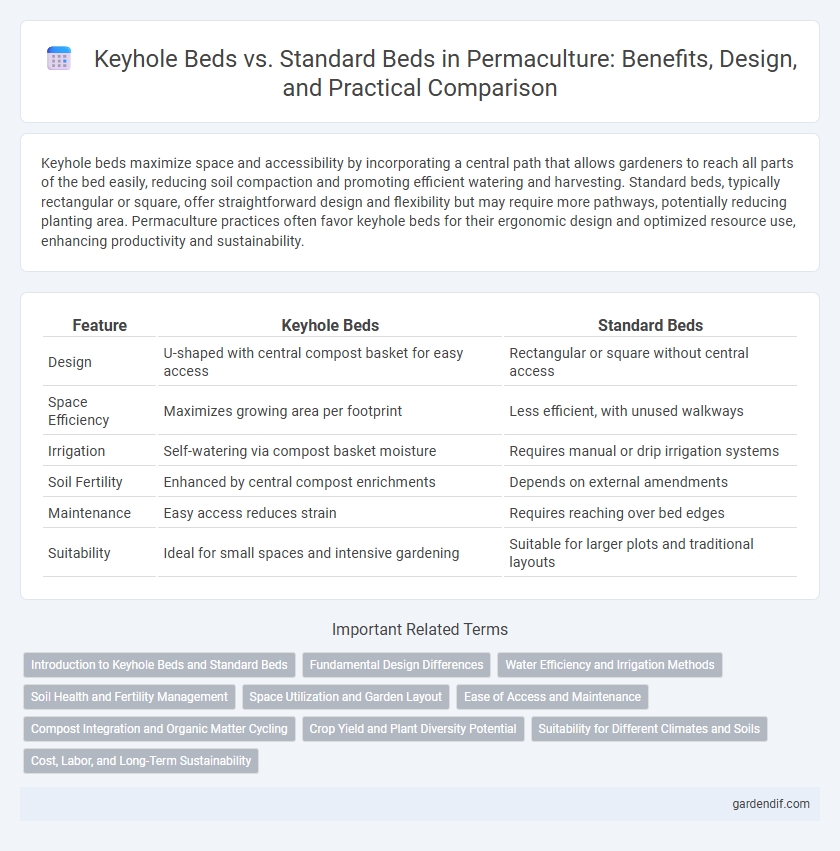
Keyhole beds vs Standard beds Illustration
Keyhole beds maximize space and accessibility by incorporating a central path that allows gardeners to reach all parts of the bed easily, reducing soil compaction and promoting efficient watering and harvesting. Standard beds, typically rectangular or square, offer straightforward design and flexibility but may require more pathways, potentially reducing planting area. Permaculture practices often favor keyhole beds for their ergonomic design and optimized resource use, enhancing productivity and sustainability.
Table of Comparison
| Feature | Keyhole Beds | Standard Beds |
|---|---|---|
| Design | U-shaped with central compost basket for easy access | Rectangular or square without central access |
| Space Efficiency | Maximizes growing area per footprint | Less efficient, with unused walkways |
| Irrigation | Self-watering via compost basket moisture | Requires manual or drip irrigation systems |
| Soil Fertility | Enhanced by central compost enrichments | Depends on external amendments |
| Maintenance | Easy access reduces strain | Requires reaching over bed edges |
| Suitability | Ideal for small spaces and intensive gardening | Suitable for larger plots and traditional layouts |
Introduction to Keyhole Beds and Standard Beds
Keyhole beds are circular raised garden beds with a central composting basket, designed for efficient space use and easy access, enhancing soil fertility and water retention. Standard beds are typically rectangular, offering straightforward planting layouts but requiring more walking space and less integration of organic waste recycling. Keyhole beds optimize nutrient cycling and reduce foot traffic, making them ideal for intensive permaculture gardening.
Fundamental Design Differences
Keyhole beds feature a circular design with a central composting area, optimizing nutrient recycling and water retention by allowing easy access to all parts of the bed through a narrow pathway. Standard beds typically have rectangular or square shapes, prioritizing simple construction and maximum planting area but often require more pathways for access. The fundamental design difference lies in the keyhole bed's efficiency in resource use and accessibility versus the straightforward, space-focused layout of standard beds.
Water Efficiency and Irrigation Methods
Keyhole beds maximize water efficiency through centralized composting zones that retain moisture and direct irrigation precisely to plant roots, reducing water waste significantly compared to standard beds. Their design facilitates gravity-fed drip irrigation systems, allowing slow, consistent watering that enhances soil absorption and minimizes evaporation. In contrast, standard beds often require more frequent, less targeted watering, leading to higher water consumption and reduced irrigation efficiency.
Soil Health and Fertility Management
Keyhole beds enhance soil health by providing concentrated nutrient cycling through a central composting basket, promoting consistent moisture retention and microbial activity. Standard beds rely on surface compost application and less efficient moisture distribution, often resulting in slower nutrient availability and uneven soil fertility. The circular design of keyhole beds minimizes soil disturbance, supporting better aggregate stability and long-term soil fertility management.
Space Utilization and Garden Layout
Keyhole beds maximize space utilization by incorporating a central composting basket, enabling efficient nutrient recycling and easy access to all plants without compacting soil. Standard beds typically require more walking paths, reducing the overall planting area and complicating garden layout. Designing with keyhole beds allows gardeners to optimize limited space, increase yield per square foot, and streamline maintenance in permaculture systems.
Ease of Access and Maintenance
Keyhole beds feature a central path allowing gardeners to reach all areas of the bed without stepping on the soil, significantly reducing soil compaction and making maintenance tasks like watering and weeding easier. Standard beds often require walking along the edges or stepping into the bed, leading to soil disturbance and more labor-intensive maintenance. The design of keyhole beds enhances accessibility and efficiency, making them ideal for maximizing garden productivity and minimizing physical strain.
Compost Integration and Organic Matter Cycling
Keyhole beds maximize compost integration by centralizing a compost basket within the planting area, enabling continuous nutrient flow and efficient organic matter cycling directly to surrounding plants. Standard beds typically require separate composting zones, which can slow nutrient recycling and reduce organic matter accessibility. Enhancing soil fertility and microbial activity is more effective in keyhole designs due to this direct and consistent compost input.
Crop Yield and Plant Diversity Potential
Keyhole beds offer increased crop yield efficiency by maximizing planting space and improving soil moisture retention, resulting in healthier, more productive plants compared to standard beds. Their circular design enables better access to the center composting area, enhancing nutrient availability and supporting diverse plant species simultaneously. Standard beds typically provide less plant diversity potential due to limited microclimates and less efficient nutrient cycling.
Suitability for Different Climates and Soils
Keyhole beds excel in arid and semi-arid climates due to their efficient water retention and centralized composting system that enriches soil fertility, while standard beds perform well in regions with consistent rainfall, allowing for easier crop rotation and large-scale planting. In heavy clay or poorly draining soils, keyhole beds facilitate improved aeration and prevent waterlogging through elevated design, whereas standard beds may require additional soil amendments to avoid compaction. Suitability depends on climate patterns and soil texture, with keyhole beds optimizing resource use in resource-scarce environments and standard beds offering flexibility across moderate growing conditions.
Cost, Labor, and Long-Term Sustainability
Keyhole beds offer a more cost-effective and labor-efficient solution compared to standard beds by reducing the need for extensive irrigation systems and allowing easy access to plants within a compact space. The design promotes long-term sustainability through improved soil health and water conservation, minimizing resource input over time. Standard beds often require more frequent maintenance and higher material costs, making keyhole beds a preferred choice for eco-conscious gardeners aiming for durable, low-impact cultivation.
Keyhole beds vs Standard beds Infographic

 gardendif.com
gardendif.com